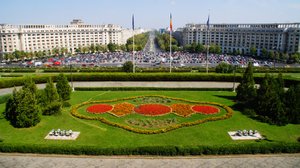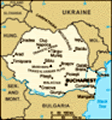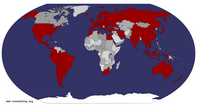Advertisement
Published: October 9th 2016

 From The Balcony Of The President's Palace
From The Balcony Of The President's Palace
Ceaucescu never did get to speak to the people from it; instead, Michael Jackson of all people was the first person to speak from the balcony as he greeted the people of "Budapest"."Always catch a bus if you can", said the guy at the hostel in Veliko Tarnovo. Shame there no buses to Bucharest then. Only trains.
Thus, I was on my first train journey for first time in a month, when I was in
Italy/San Marino. And it was nice crossing a border with company, especially a long, 7-hour journey with so many stops. With me were three others from the hostel in Veliko Tarnovo; American Maura and fellow Kiwis Tom and Louis, who despite their rather contrasting appearances, are quite astonishingly, brothers. It was nice to hang out with some Kiwis again for a longer period of time - I haven't met too many on my travels to be honest and many of those meetings were rather fleeting. Only Andy in
Havana springs to mind in terms of 'travelling' with another Kiwi for a few days.
Romanian is derived from Latin and is much like Italian, which is much like Spanish, so I found I could understand all the signage on arrival in Bucharest. And as opposed to
Bulgaria, they use the Roman alphabet here so I could actually read it!
Getting on the efficient metro, there was a busy, big-city

 Presidential Palace
Presidential Palace
The second largest administrative building in the world after The Pentagon.feel about Bucharest which was kind of welcoming and familiar.
But going out to get a feed after checking in at the hostel, Tom, Louis and I found that the first few locals we met weren't as friendly as they were in back in Bulgaria - and that things weren't as cheap here either. 4€ for a kebab? You're having a laugh, mate. Surprisingly, I found during my stay in Bucharest that street food - so things like kebabs - is disproportionately expensive.
Walking tours are a great way to see a few of the main sights of a city while learning something about what you're seeing at the same time. And so Tom, Louis, Maura and I reconvened for Bucharest's free walking tour. Vlad, our guide was humorous, energetic and informative and we definitely all learnt a few things about Romania that morning.
Like for example, that Bucharest was founded by a shepherd named Bucur and prior to conquest by the Romans, Romania itself was first inhabited by tribe of Thracians known as the Dacians - hence I discovered that the automotive manufacturer Dacia, is therefore Romanian.
Then conquered by Roman Emperor Trajan, the country became fully integrated

 Pasajul Macca-Vilacrosse
Pasajul Macca-Vilacrosse
Old and pretty glass arcade that is now home to many a cafe.and colonised by Romans and this intense Romanisation is believed to be why Romania is named as such and also why the language is Romantic - just like Spanish, Italian, French and Portuguese - with its roots in Latin, rather than Slavic, like all of Romania's neighbours.
Following the decline of the Roman Empire, three distinct provinces of Romania eventually formed; Wallachia in the south which was primarily ruled and influenced by the Ottomans; Moldavia in the north west with its heavy influence by the Russian Empire; and Transylvania, influenced and ruled by Austro-Hungaria and the famous birthplace of Count Dracula, the original vampire who was in turn inspired by the real-life Vlad Dracula or Vlad The Impaler, born in Transylvania and ruler of Wallachia. Although more famous for torturing and impaling criminals and enemies, Vlad Dracula is in fact a bit of a Romanian hero for his stoic defence of his land and people from the Ottomans. There is a statue of him in the old town of Bucharest, right next to the Old Princely Court Church, where St Anthony may or may not grant you a miracle every Tuesday should you pray for one.
Right opposite the Old

 Statue Outside The National History Museum
Statue Outside The National History Museum
The statue is of Roman Emperor Trajan holding a wolf that symbolises Romania's history. However, at its unveiling, the audience reacted with silent incredulity and one member shouted out to "put the cover back on!"Princely Court Church is Hanu' Lui Manuc, an old inn and commercial centre dating from the 19th century that was originally built to shelter and protect caravans along the trade route from Istanbul to Western Europe, from bandits.
The most interesting piece of history that we learnt was from much more recent times and the Communist reign of megalomaniac Nicolae Ceausescu. Like almost all of its neighbours, Romania turned to Communism after WWII and the country was soon under the control of Ceausescu's iron fist. Vlad then told us of some quite shocking living conditions that he experienced first-hand under Ceausescu's rule, such as no electricity after 7pm, only two hours of hot water a week and meagre food rations. This soon led to an uprising in 1989 and an eventual protest outside the university where 2,000 peaceful protestors were killed by troops on Ceausescu's orders. It sounded almost identical to the Tiananmen Square massacre. In response, over 150,000 people showed up in the square the next day and when the army turned, the game was up for Ceausescu, who fled, was caught, was tried and then was executed on live television. However instead of ushering in democracy, Communist

 Stavropoleos Church
Stavropoleos Church
Beautiful old Greek monastery in the old town that combines a number of different architectural styles.cronies from Ceausescu's government came into power and similar protests were crushed by secret police disguised as miners and thugs. Slowly but surely however, the old cronies either died or left power and gradually, true democracy eventually came to fruition in modern-day Romania. The stories of the revolution and Vlad's personal experiences were moving and it capped off one of the better walking tours that I have done on this trip so far.
Later that afternoon Maura and I chilled out at Herastrau Park, Bucharest's biggest which came complete with a huge lake and boat rides on it. It is Bucharest's answer to Central or Hyde Park although disappointingly, the Village Museum displaying rural Romanian buildings was closed (annoyingly it turned out that it wasn't closed - we had just gone to the wrong entrance).
Vlad had told us about some mouthwatering Romanian dishes on the walking tour and it was enough for us to want to splash out a bit to treat ourselves and sample it. Although the restaurant we wanted to visit was mysteriously not accepting diners, we did eventually end up at another place serving traditional fare in the old town. For lunch I had
ciorba 
 Old Town Bucharest
Old Town Bucharest
The old, pedestrianised town centre is nice to walk around with all its restaurants, bars and cafes even if it isn't the most authentic old town I've ever visited.- sour soup similar to
Russian borscht which is great for hangovers apparently and was nice enough - but for dinner I had
sarmales which were delicious cabbages stuffed with mincemeat, peppers and paprika. They were nice but perhaps a tad too salty. They were similar to the stuffed cabbages I had in
Lithuania some three years ago.
But the highlight was definitely the
papanasi - a large, freshly fried donut served with sour cream and plum jam. Man, it was the best dessert I have had on the trip so far and perhaps the best dessert I have had full stop. OMG. We finished our night off with a shisha pipe and a drink at one of the cafes in Pasajul Macca, a cute glass arcade.
The next day, the Kiwis and I visited Bucharest's biggest attraction; the Palace of Parliament, which after the Pentagon, is the biggest administrative building in the world with 365,000 square metres of space. Unsurprisingly the brainchild of Ceausescu, a tour of just some of its 1,100 rooms can only be done with a guide and unfortunately for us, we happened to be guided around by a robot. Let's just say our guide wasn't the most energetic nor

 Rebirth Memorial
Rebirth Memorial
This obelisk piercing an egg-like object is also known colloquially as "The Potato". It's a memorial for those who died in the protests against Ceaucescu's leadership in 1989.charismatic guide I've ever had and the monotone regurgitation of his lines didn't help. Nevertheless the interior was quite impressive - although you'd expect it to be - with some huge and elaborately decorated rooms. The theatre and main hall were the most impressive rooms; paying 7€ for the privilege of photographing them would not have been worth it but mainly because I managed to snap a few sneaky photos on my phone anyway. By the end we had viewed just 5% of the entire building; only 30% is actually used and the €6bn annual cost of maintaining it could provide electricity for a medium sized city. Evidently, it divides opinion among locals. After the tour it is hard to say where this particular palace would rank out of the ones I have seen - but I don't think it'd be number one.
As well as being the heaviest building in the world, the building is known by locals as "The Iceberg" since more of it is underground than above it. Nintey-two metres below is a nuclear bunker which is connected to other state institutions via 20km of tunnels. Perhaps unsurprisingly, the lads from Top Gear had a race through

 Eden Club
Eden Club
Awesome and large beer garden that I had a couple of drinks at on my last night in Bucharest.the tunnels. We didn't get to see any tunnels on the tour disappointingly, just a peak at the building's foundations which were just huge blocks of concrete.
After bidding farewell to Tom and Louis, I then visited the National History Museum (complete with weird statue out the front) which was disappointing. It comprised of three sections; a collection of objects guiding you through Romania's history; an exhibition of jewellery, crowns and gold and silver objects (some impressively dating back to 17,000 BC); and an impressively intricate deconstructed replica of Trajan's Column in Rome. There was a section showcasing entries to a competition to redesign the National History Museum, where I learnt that the current building has a few problems with it, meaning it was unable to showcase all of the artefacts it possesses - which was probably why the museum seemed so light on content.
On my final night in Bucharest, I met up again with Maura and Max, a Swiss guy who was also at our hostel in Veliko Tarnovo, who had just arrived in the city. Bringing with them another couple of Germans from their hostel, I think that the Germans felt quite at home at

 CEC Palace
CEC Palace
Opulent building that is the headquarters of Romania's oldest bank.the awesome, German-style beer garden that we convened at. Hidden away from the street, the place is huge and tables are set up among all the bamboo trees that forest the garden. The beers were all craft or imported meaning that once again, things weren't cheap here, but I noticed all over the city that the idea of a German beerhouse is quite popular in Bucharest.
And it seems that no-one sleeps in Bucharest apparently as I witnessed non-stop traffic every bit as busy as it was during the day, on one of the main streets on my walk home at 1am. There were plenty of others still up too on what was a Wednesday night.
"Non-stop" funnily enough, is the moniker given to 24-hour mini-markets here in Romania.
There are a lot of people asking for stuff on the streets and on the metro here in Bucharest, which if you were to believe in the common perception of Romania as being a land of gypsies and pickpockets, is perhaps not surprising. Perhaps it is a perception that held more truth maybe ten years ago but is more than a bit unfair now. While there are quite a lot

 B-dul Unirii
B-dul Unirii
Bucharest's 'Champs Elysees' built by Ceaucescu. The main boulevard that leads to the Presidential Palace was deliberately made 6m longer than the actual Champs Elysees.of homeless people around, I didn't think that it was substantially more than I had seen in other cities in Europe.
I didn't spot as many of the local Roma population as I thought I might, but the ones selling things like roses and tissues on the street inevitably were.
I wouldn't say that Bucharest is an especially pretty city but it's no hole either. It is reasonably modern and there is bustling energy about the place.
I feel that there is more to this city if you dig a bit deeper - cool hangout spots, neat bars - and I certainly wouldn't scoff at any opportunity to live here. There seems to be a lot of young people here to keep an underground culture here alive. But as a tourist I was done here after two full days and it was time to move on; this time, to scary and castle-ridden countryside of Transylvania! *thunder clap and lightning flash*
Pe curând...in speranta...
Derek
Advertisement
Tot: 0.09s; Tpl: 0.017s; cc: 14; qc: 27; dbt: 0.0416s; 1; m:domysql w:travelblog (10.17.0.13); sld: 1;
; mem: 1.2mb



























